Tuesday August 1 to Wednesday August 2 - With breakfast-enhanced wakefulness, we loaded up the van and after a last farewell tour through the water front (resulting in a planned delay of 15 minutes) we hit the Trans Canada Highway headed west. With all the practice we had over the last few days, we had no trouble staying on the correct route.
In short order, we passed the turn off to Kevin's cottage at Middle Gull Pond. From this point onward, this was road that we had never, as a group, seen before. The day was perfect for driving -- clear but with just enough cloud cover so that there was no bright sun glare.
We were traveling with three children, so rest stops were frequent. The first of these, about half way between St. John's and Terra Nova National Park, made me briefly nostalgic for my childhood in northern B.C. The place was a store, a restaurant, and a gas station beside the highway. If you right-click on the image, select "Save Link As" and save the picture, then load the picture using a utility like ACDSee and zoom in, you can see Chris in the van tweaking his GPS device.
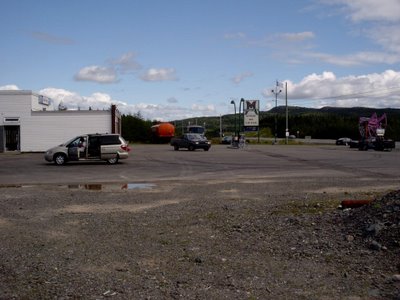
There is only one road through Newfoundland, so we had no choice but to follow the twisty route of the Trans Canada. Many roads led away from the highway toward the northern coast, to little coastal villages. Even with the highway, there are still Newfoundland outport communities that can only be reached by seaplane or by boat.
This was not the case of Gambo, where we made another rest stop. Gambo is right by the highway, and its claim to fame is that it is the home town of Joey Smallwood, the Newfoundland politician who presided over Newfoundland's entry into the Canadian Confederation in 1949.
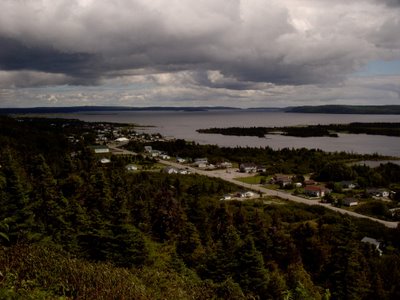
Lunch was in Gander in the early afternoon. In order not to traumatize finicky palates, we ate at a chain restaurant called Jungle Jim, whose only virtue was that the children liked it.
We also filled the tank again in Gander. The gas price per litre in St. John's had been around $1.20 per litre -- compared with a price in the mid to high 90s back home in Toronto. We had been braced for even worse sticker shock on the highway, but the price was about the same. After a second refill late in the afternoon, we eventually reached Deer Lake, and less than an hour after that, we reached the edge of Gros Morne National Park.
By this point, we had been on the road for over nine hours, and fatigue levels were getting high. A combination of games, comic books, books, strategically doled out snacks, and games played on the PSP or my Palm kept the children more or less harmlessly occupied. However, there was some inevitable conflict, even though all three children were real troupers through what was a long and grueling drive. There was one funny moment when after a brief spat, Robin's voice rang out in the sudden silence : "Things would go so much better if you people would just do what I want."
Our ultimate destination was right on the western coast, a community called Norris Point, close to a slightly larger place called Rocky Harbour. Both towns were surrounded by the Gros Morne wilderness -- a land of rock and high cliffs, forests, and the ever-present sea close by.
Months previously, we had planned for a week in Gros Morne, and through the magic of the internet, had found Judy Reid and "Reid's Tourist Home" -- our home away from home for the next week in Norris Point. Judy wasn't available the day we arrived, so she had arranged to leave the cottage unlocked so we could get in.
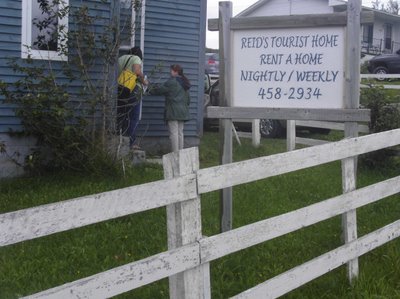
This "cottage" was actually slightly larger than our house! Clean, neat -- it would have passed much stricter standards than those of a slob like me.
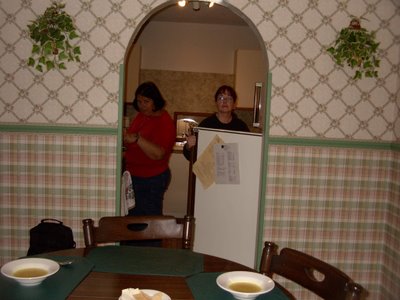
The road leading to the cottage was called Neddie's Harbour Road. It had followed the edge of a harbour, which we assumed to be Neddie's Harbour, and beyond the cottage, it disappeared over a hill. A few days later, Chris and I and the kids walked along the road to find a small graveyard, a gravel pit, a small wood cutting operation, and a water treatment plant.

But the first night was a night to wind down. Relaxation was facilitated by the fact that the convenience store next to the Esso service station at the beginning of Neddie's Harbour Road was also a beer store. Snacks, beer, and barbecued pork chops went a long way to restoring good cheer after the long drive.
The next day, our first full day in Norris Point, was taken up with administration and research. After a long sleep, followed by a leisurely breakfast and lunch, we drove out to the Visitor Centre to get maps of the park, and then into Rocky Harbour in search of a laundromat.
As we turned from the road from the Parks Canada Visitor Centre onto the road going to Rocky Harbour, we saw a moose beside the road -- we were less than two road widths away from it. It chewed its plant fodder oblivious to our frantic photography.
In Rocky Harbour, we found the laundromat, and restocked on groceries. Liza and Jill found a place which sold crafts and souvenirs. That evening, we ate dinner at a restaurant called Jackie's, where I ate real Newfoundland cod.
Once we got to the shore, it was also obvious why the community was called "Rocky Harbour". Rocks littered the harbour, carried there by glaciation during the last ice age.
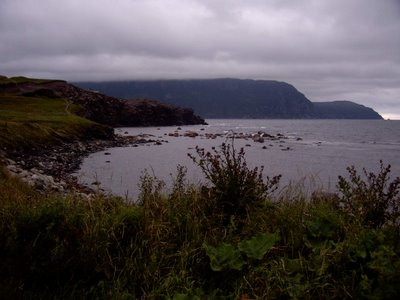
Thursday August 3 - On our second full day in Gros Morne, the objective was to visit a little piece of Mars on Earth.
The place we needed to initially get to was (theoretically) visible across the harbour, a place called Bonne Bay. From Bonne Bay, there was a road that led to Trout River. Lacking a car ferry to take us and our faithful van across the harbour, we instead backtracked thirty or forty kilometers to a point outside the park, to pick up the road that got us around to the other side of the harbour to the road to Trout River Pond.
We got there in time to have a quick lunch (sandwiches in a covered picnic area) and make the early afternoon boat tour.
In one of the local variations of meaning, the word "pond" in Newfoundland is a reference to a lake. This linguistic evolution is probably reasonable when one considers that Newfoundlanders, faced with the reality of the North Atlantic, are not at all impressed by any other body of water.
Trout River Pond was a fjord which became landlocked as a result of geological reshaping during one of the Ice Ages. The cliffs which border it are very important for insight into the forces which have driven our planet's geological evolution. On one side, there are familiar granite cliffs, such as one might see in Northern Ontario. On the other side side, the cliffs start as normal rock, but there is a transition point, and beyond that point they are mostly bare of any growing thing, and they have an orange-yellow colour. They are composed of peridotite, a mineral that normally exists deep in the earth, typically at the depth of the Mohorovicic Discontinuity, which marks the boundary between crust and mantle layers in the Earth's structure. This part of Gros Morne is known as the Tablelands.
The day was cloudy, with occasional periods when the sun would shine. It was quite cool on the boat -- we were all glad to have brought sweaters and jackets. The boat itself was a slightly larger version of the whale watching boat that we had encountered a couple of days previously. It was also obvious that the tour operators were old hands at this -- the tour ran smoothly, and the commentary was well done.
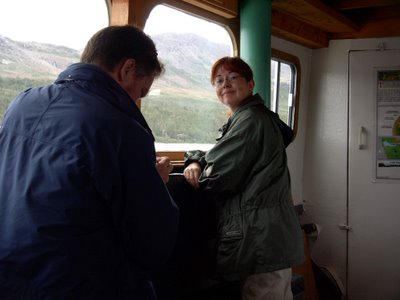
The transition from "normal" rock to peridotite was quite abrupt. Normal rock weathers, and is subject to erosion by natural forces, including biological activity -- plants take root, and in the process create more soil on the rock and in cracks in the rock, allowing further generations of plants to grow. And eventually, an entire ecosystem develops on the mountain or cliffside.
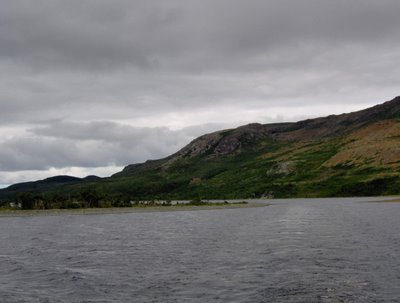
Not so with peridotite. Although peridotite is subject to erosional forces due to wind and water (in fact, it wears away more easily than granite does), nothing grows on it, because it is toxic to plants. The toxicity is due to the presence of heavy metals. Very hardy plants have taken root, in crevices filled with wind-blown soil, but these are rare, and when found, they are small and spindly.

After the tour, on our way back out toward the main highway, we stopped at a place where the road formed a divide between the two kinds of Tableland rock. The stark, lifeless, yellow orange landscape, lit by a cloud attenuated sun, was unearthly. It is almost certainly the closest that I will ever get to a first hand look at the surface of Mars.

Olivine is a component of peridotite -- a substance which has been verified to be present on the Martian surface by both Spirit and Opportunity. In the Tablelands, the peridotite originated in the Earth's mantle. The Tablelands were formed when two continental plates collided, causing material from deep within the earth to be upthrust. Gros Morne and the Tablelands provide fine examples of the result of this ancient geological activity for study, one of the reasons why it was designated as a UNESCO Heritage Site, in addition to being a National Park.
On our way back to Norris Point, on the main road (Highway 430), we encountered a pair of moose beside the road -- a mother and her calf. We stopped to take photos, and over the course of ten minutes or so, four or five vehicles stopped to join us. The moose eventually slipped into the forest, and we continued on back to Norris Point.
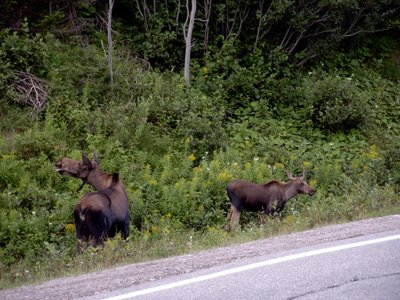
Friday August 4 - With the weather forecast showing that Friday would be reasonably clear, we decided to make the long trip up north to L'Anse Aux Meadows. We were on the road just after 7am, which was a bit of a struggle. We passed through all of Gros Morne, following highway 430 northward to the very northern tip of the island of Newfoundland.
When I got the tire repaired earlier in the week, I had gotten a set of "moose whistles" from the outdoor section of the Canadian Tire store, in anticipation of driving in Gros Morne and the west coast. Before starting that morning, Chris and I fastened them to the van with packing tape. On the way up north, we passed through a coastal community, and saw two moose ambling through an industrial area beside the highway. This was our first, but by no means last moose encounter of the day.
Including rest stops, the trip up took about four hours. In the last part of the drive, highway 430 paralleled the Newfoundland coast. We could see Labrador, ten or fifteen kilometres away across the Strait of Belle Isle.
For personal and cultural reasons, I have always liked to seek out and eat in Chinese restaurants in small communities when I travel. It is the whole reliving my past thing, since Chinese restaurants, after all, reflect my personal roots. However, on this occasion, I was outvoted. We had lunch at the Tim Horton's in St. Anthony. From the promotional place mat on the table, however, I learned that there was not one, but actually two Chinese restaurants in St. Anthony.
After lunch, we made our way north back along 430 to its intersection with Highway 436, and followed 436 to the coast, to the National Park that enclosed the L'Anse Aux Meadows site.
L'Anse Aux Meadows is not very far north -- at least, not according to the standards of someone born in Northern B.C. It is at a latitude that puts it at same or a bit south of the latitude of Moose Factory, Saskatoon, Edmonton, or Prince George. But north of this point (not quite the most northerly point of the island of Newfoundland), there is nothing but water -- the North Atlantic eventually becoming the Arctic Ocean.
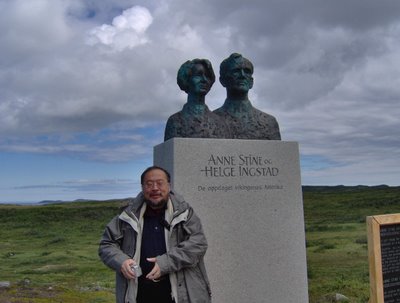
It was here, around the year 1000 -- 500 years before Columbus and John Cabot -- that Vikings made landfall on the North American continent and built a small settlement. This discovery was made in 1960 by the Norwegian explorer Helge Ingstad and his wife, archaeologist Anne Stine Ingstad. The commemorative plaque, a corner of which is seen in the lower right hand corner of the photo, reads as follows (also in French)-
ANNE STINE AND HELGE INGSTAD
REDISCOVERING THE AMERICA OF THE VIKINGS
A GIFT FROM THE PEOPLE OF NORWAY
UNVEILED BY H.M KING HARALD V ON MAY 11, 2002
SCULPTOR: NILS AAS. THE STATUE IS A REPLICA OF THE ORIGINAL,
WHICH STANDS NEXT TO THE ENTRANCE OF THE
VIKING SHIP MUSEUM IN OSLO. THE ORIGINAL STATUE
WAS UNVEILED ON JANUARY 25, 2001 BY KING HARALD V
IN THE PRESENCE OF HELGE INGSTAD.
THIS GIFT HAS BEEN MADE POSSIBLE THROUGH THE SUPPORT OF
NORSK HYDRO AND THE ROYAL NORWEGIAN
MINISTRY OF FOREIGN AFFAIRS.
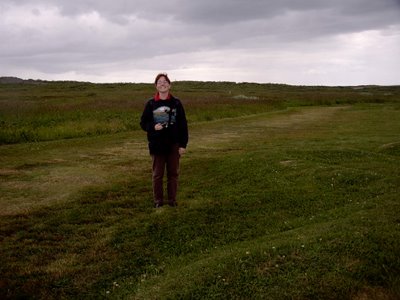
Between 1961 and 1968, an international team of archaeologists led by Anne Stine Ingstad excavated the remains of sod houses, artifacts, a forge, various work areas, and firepits. All of these dated back to a 15 to 20 year stretch around the year 1000 when Vikings, travelling from their existing settlements in Iceland and Greenland, would have periodically inhabited this site.
All that remains now, a thousand years later, are ridges and depressions marking the former location of walls.
The archaeological site is well maintained, complete with metal plaques identifying individual building locations. Off to one side, away from archaeologically interesting spots, there is a recreation of a Viking sod house, with two historical interpreters inside dressed in appropriate costumes. Chris and Cameron tried on Viking helmets, and were allowed to handle spears, shields, bows, and arrows.
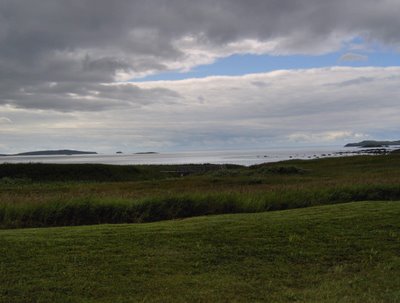
A thousand years ago, the scene above is what the Vikings would have seen as they looked out to sea from the shore of their settlement. For purposes of this photo, just assume that the Viking longboats are drawn up on the beach, off to the left, and not visible in the image.
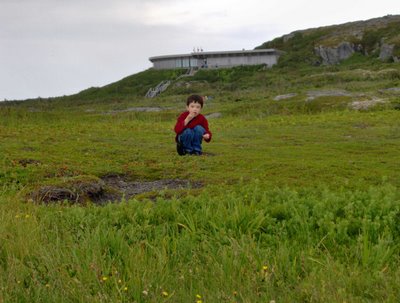
Like the rest of Newfoundland, this coast was very rocky, leading to the acidic soil conditions that are ideal for blueberries. In fact, in the ground cover off the walkways, there were many blueberries, and in the photo above, you see my son foraging for them, with the Parks Canada visitor centre/museum in the background.
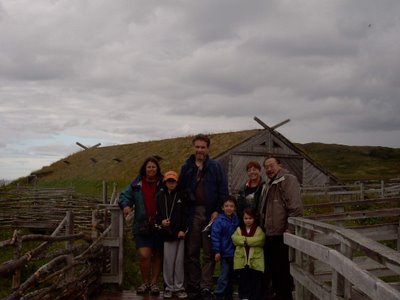
We left the L'Anse Aux Meadows archaeological site and went a couple of kilometres further down the road, to Norstead -- a recreation of a Norse trading port. Norstead is a simulated Norse community -- complete with animals, and interpreters in costumes. There were also replicas of artifacts -- made from wood or bone or wool or even metal, by hand, using original techniques.
The group shot above is courtesy of a passing fellow visitor just outside the sheep pen.
Norstead had another sod house, probably a little less authentic because of the extensive amount of wooden timbers used in its construction. We saw bushes and ground cover, but no mature forest. The unanswered question for me was whether there originally would have been trees for timber, and whether the current lack of trees was due to modern logging? There was also a church (the Viking travelers of the year 1000 would have been recent converts to Christianity, some still secretly worshiping Odin and Thor), a smithy, and a boat shed which held the Snorri -- a replica Viking longboat which made the crossing from Greenland to L'Anse Aux Meadows in 1997/1998.
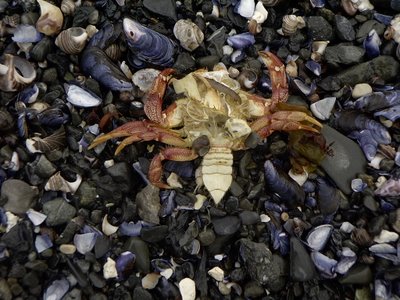
Norstead also had a rocky beach down from the boat shed -- we found an assortment of shells (mostly mussels), an eviserated crab (above) probably caught and eaten by a seabird.
Norstead closed late in the afternoon, and we were among the last to leave, along with the staff. We had dinner (more cod for me), and then headed back south. Sunset was around 8:00, with progressively deepening twilight over the next hour. On the drive back, Liza and Jill counted more than a dozen moose beside the highway -- none close enough to present a danger, but nerve-wracking nonetheless. Based on experience and observation, our collective belief is that the moose whistles don't work.
Sometime after 1:00 in the morning, we pulled into the driveway of our home away from home in Norris Point. The night was clear and quite cool. On the deck, looking northward, I saw Ursa Major shining in a sky filled with stars normally invisible in the city. A bright meteor made a sudden streak across the sky. Sadly, this was the only clear night that stargazing was possible, and we were all too exhausted to do anything about it.
Saturday August 5 to Monday August 7 - The next three days were devoted to exploring more of Gros Morne, Norris Point, and Rocky Harbour. Saturday afternoon included a trip to the Bonne Bay Marine Research Station in Norris Point, an hour hanging out with the children in a playground, followed by dinner in Rocky Harbour.
Following the road through Rocky Harbour north along the coast (thanks to Chris' GPS device and set of PalmPilot maps), we reached Lobster Cove Head. From the cliffs here, we could look south and see Rocky Harbour. The cliffs also provided the vantage point for the lighthouse.
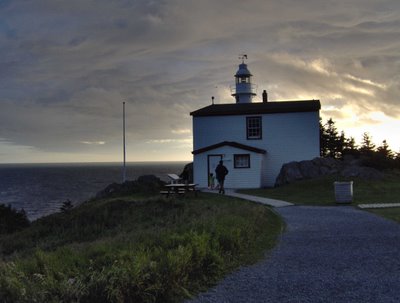
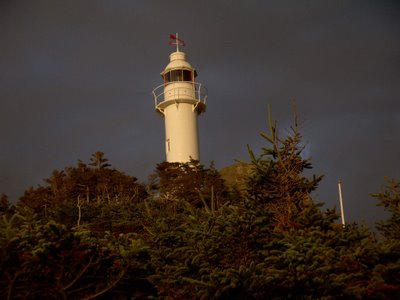
The children climbed the rocks around the lighthouse, while we took advantage of photo opportunities in the scenic surroundings. I have a highly blurred image of something long and sinuous and black (a marten, perhaps?) that raced out of the underbrush and zipped into another clump of brush and trees by the edge of the high fenced off cliff that overlooked the ocean.
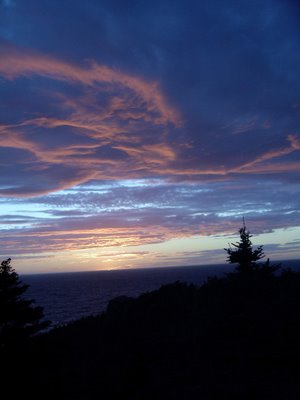
Sunset occurred at 19:57:46 according to the timestamp on my digital camera. A fairly substantial group of people (20? 30?) gathered to watch the sunset - some locals, others tourists like us.
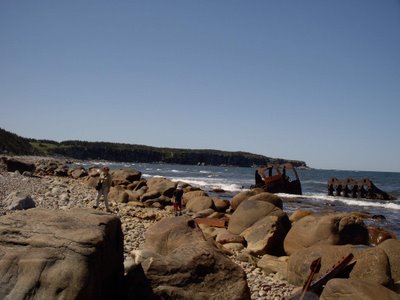
On the following day, our travels took us to the site of the wreck of the S. S. Ethie, one of the ships of the "Alphabet Fleet" of Sir Robert Reid. The ship went down in an ice strom in 1919, with no loss of life. Remains of the engine and boiler are still on the beach, the rust softening sharp edges, and the pieces slowly crumbling into oblivion.
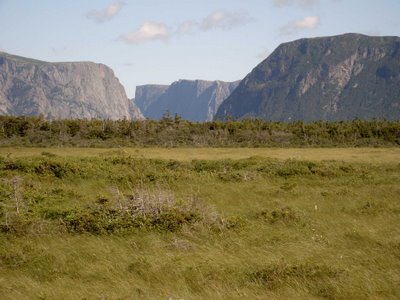
We paused briefly at a scenic lookout point beside the highway where we could see the Western Gap, marking a passage into the Long Range Mountains. These mountains are an extension of the Appalachians which extend all the way through to Tennessee and Alabama in the United States. They are ancient -- dating back almost 700 million years when various continental plates came together to form the supercontinent of Pangaea.
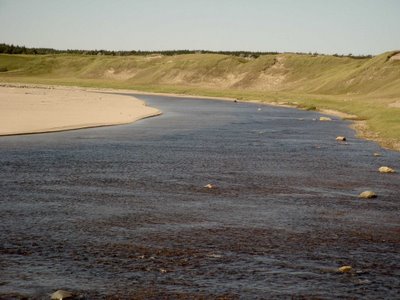
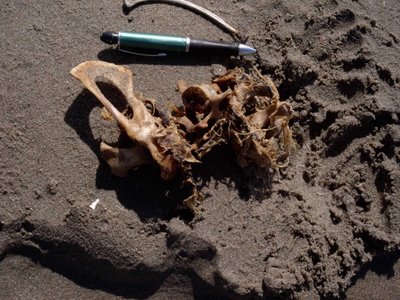
After lunch, we went to Western Brook Pond. We found an immense sandy beach, almost deserted, sandwiched between a stream meandering to the shore of the ocean, and the ocean itself. The sand dune environment here is quite similar to that of the Pinery Provincial Park in Ontario -- not a place that Jill or I have any experience with, but quite familiar to Chris and Liza. Walkways had been constructed through the dunes, and marran grass and trees planted to hold the dunes in place. Even so, the dunes are unstable -- disruption of a strategically located bit of ground cover (by, for instance, a careless foot) might result in the wind over time carving away the dune.
While there, I found some bones in the water -- the freshwater river side, not the ocean side. This is my "CSI" photo, complete with my trusty pen to establish scale. What was it? There are vertebrae, what to my untutored eye could be a pelvic bone. I am thinking this is the remains of someone's barbecue, or perhaps a small animal that was killed and eaten by a fox.
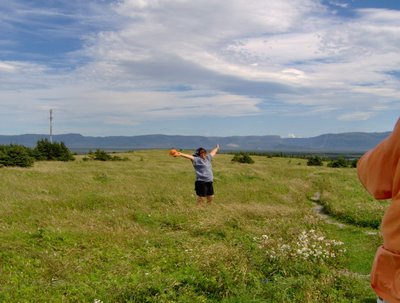
Monday was our last full day in Gros Morne. Our intention was to go back to the sandy beach of Western Brook Pond. We were disappointed by the extreme wind. At Shallow Bay and Cow Head, at the northern end of Gros Morne park, we encountered wind so extreme that it was possible to lean into it and be supported by it. The wind combined with a sandy beach would not have been a pleasant experience.
Instead, we explored Cow Head - walked up to the lighthouse at the top, and back down again. At one point, we found a wide expanse of grass, which combined with the strong wind allowed Liza to have her "Sound of Music" moment.
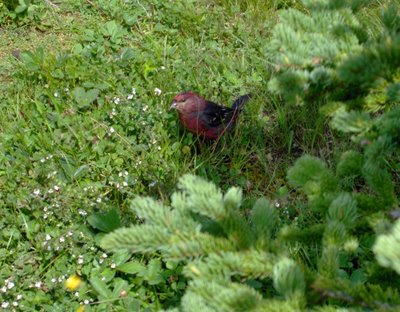
Returning from the top of Cow Head, we encountered a pair of birds -- a mated male/female pair, obviously trying to distract us from something important close by.

As we left, we took a photograph that we knew our friend Lorna would appreciate.
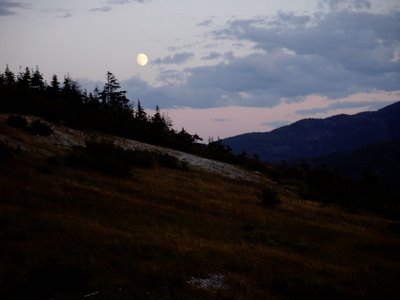
The moon shared the sky for our last sunset in Gros Morne -- it had been a memorable week.
Continued in Part 4.




No comments:
Post a Comment